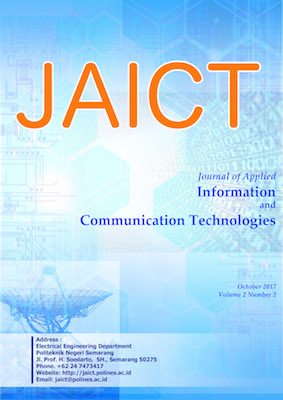Handover Analysis Of Data Services In Wireless Distribution System (Wds) Using IEEE 802.11ac Standards In Telecommunication Laboratory Polines
DOI:
https://doi.org/10.32497/jaict.v2i2.1344Keywords:
Handover, WLAN 802.11ac, Wireless Distribution System, Quality of ServiceAbstract
Problems with limited WLAN coverage areas often become a constraint when users access the Internet by migrating. This final project contains an analysis of the effect of handover on the quality of data service with Quality of Service (QoS) parameter that is throughput, delay, jitter and packet loss. The Wireless Local Area Network (WLAN) 802.11ac networking system in the Telecommunication Laboratory of Semarang State Polytechnic area that supports the handover feature is built with the Wireless Distribution System (WDS) technique that is configured with Service Set Identifier (SSID), the same password and channel and the placement of Access Point (AP) with overlapping coverage areas in one roaming domain. The tool used is Wireshark obtained the results of the test that is the average throughput value on the download service of 12,94 Mbps, the upload service of 11,22 Mbps and video streaming service of 3,66 Mbps. The average value of delay in the download service is 0,99 ms, the upload service is 1,19 ms and the video streaming service is 3,07 ms. The average value of jitter on the download service is 0,36 ms, on the upload service of 0,35 ms and the video streaming service is 3,66 ms. The average value of packet loss on the download service is 2,57 %, the upload service is 5,08 % and the video streaming service is 7,03%References
Amalina, E. N., Setijadi, E., & Suwadi. (2013). Perbandingan Topologi WSN (Wireless Sensor Network) Untuk Sistem Pemantauan Jembatan. Prosiding Conference on SmartGreen Technology in Electrical and Information Systems, 85-90.
ETSI. (2017, Agustus 2). Telecommunications and Internet Protocol Harmonization Over Networks (TIPHON) General aspects of Quality of Service (QoS), TR 101 329 V2.1.1
(1999-06). Retrieved from http://www.etsi.org/deliver/etsi_tr/101300_1 01399/101329/02.01.01_60/tr_101329v0201 01p.pdf Firdaus, Fahri, M., & Nuraini, E. (2014). Dasar dan Perancangan "Wireless ICT Networks" 3G-4G LTE4G Wimax-5G-Satelit. Yogyakarta: UII Press.
Gast, M. S. (2013). 802.11ac: A Survival Guide. Sebastopol, United States of America: O'Reilly Media, Inc. Mishra, A., Shin, M., & Arbaugh, W. (2003). An Empirical Analysis of the IEEEE 802.11 MAC Layer Handoff Process. Roshan, P., & Leary, J. (2003). 802.11 Wireless LAN Fundamentals. San Jose: Cisco Press. Sofana, I. (2014). CISCO CCNA & JARINGAN KOMPUTER. Bandung: Informatika. Soyinka, W. (2010). Wireless Network Administration A Beginner's Guide. New York, United States of America: McGraw-Hill Companies. Stallings, W. (2007). Komunikasi dan Jaringan Nirkabel (2 ed.). (G. Sagara, Ed., & D. A. Sasongko, Trans.) Jakarta: Penerbit Erlangga. Tao, L., & Yu, F. (2012). Delay-Jitter aware slot assignment for Real-Time applications in wireless. Computer Communications, 19671982. Towidjojo, R., & Eno, M. (2015). Router Mikrotik : Implementasi Wireless LAN Indoor. Jakarta: Jasakom. Wulandari, R. (2016). Analisis QoS (Quality of Service) Pada Jaringan Internet (Studi Kasus : UPT Loka Uji Teknik Penambangan Jampang Kulon-LIPI). Jurnal Teknik Informatika dan Sistem Informasi, Vol.2, No.2, 162-172.
Downloads
Published
Issue
Section
License
Authors who publish with this journal agree to the following terms:Authors retain copyright and grant the journal right of first publication with the work simultaneously licensed under a Creative Commons Attribution License that allows others to share the work with an acknowledgement of the work's authorship and initial publication in this journal.
Authors are able to enter into separate, additional contractual arrangements for the non-exclusive distribution of the journal's published version of the work (e.g., post it to an institutional repository or publish it in a book), with an acknowledgement of its initial publication in this journal.
Authors are permitted and encouraged to post their work online (e.g., in institutional repositories or on their website) prior to and during the submission process, as it can lead to productive exchanges, as well as earlier and greater citation of published work (See The Effect of Open Access).






